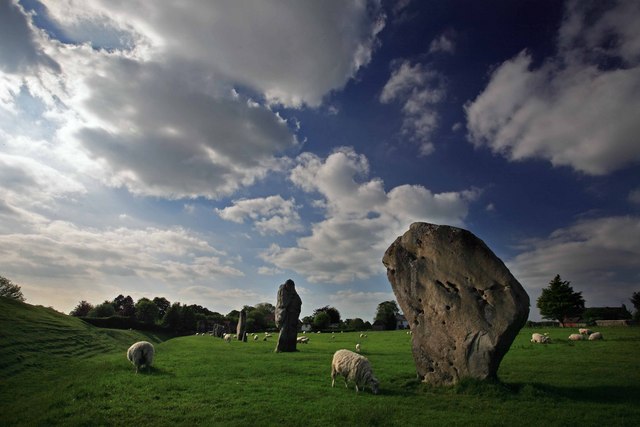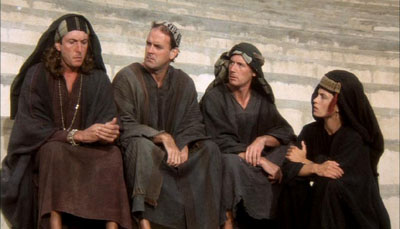#druiddebate ; or the Story CoBDOHADEH.
Heads up to @matthewpope, who wrote this post on the recent #druiddebate launched by the BBC in response to a letter from King Arthur Uther Pendragon insisting that the display of human remains at the Alexander Keiler Museum in Avebury is unethical. I personally think his point that there is some seriously slippery slope between identifying 'indigenous' heritage and nationalist narratives is pretty critical, but of course there is a whole wealth of thought on that subject (go google 'Nationalism in Archaeology' and get back to me in a few years).
Anyhow, this got me thinking about the why this story has popped back up after the furore of the reburial requests circa 2006-8, and why archaeologists seem to not have quite squeezed the last lessons out of the original English Heritage consultation on the reburial request, despite the existence of thoughtful reflections like Mike Pitt's open access PIA article. I don't claim to know quite what those lessons are, but if we're still having this conversation 5 years later, I think we should start at the beginning.
I'd also like to stress that heritage isn't my beat, and I certainly don't speak for my employer or any of the folks mentioned below.
Caveats aside, a brief history of the Story of CoBDOHADEH and the Avebury burials:
The Council of British Druidic Orders (CoBDO) describe themselves as an umbrella group with
.
King Arther Uther Pendragon, who holds what one imagines is the fairly unique position of 'Battlechieftan' in the organisation, is a happily vocal combatant in the murky waters of indigenous British heritage, and tends to get the lion's share of media coverage. He's the one who wrote the recent letter, and the reason we're having this conversation.
But really, this whole process started almost 7 years ago. In 2006, Paul Davies of CoBDO requested that the remains excavated at the archaeological site of Avebury be reburied. He made this request based on three criteria:
This set off a flurry of soul-searching at English Heritage (EH). There wasn't necessarily a framework in place to identify who, in Britiain, had the best claim to the human remains uncovered in archaeological excavation unless they were demonstrably within a church (or other religious establishment) burial ground.A major consultation was carried out in 2008 which brought additional parties into the fray, and further arguments for the right of different groups to demand reburial of remains excavated in England.
Tensions appeared well before then, however. For one thing, CoBDO itself disavowed Davies, insisting he didn't have the right to speak for their community. CoBDO then released its own statement on the remains, emphasising that reburial was to be considered on a case-by-case basis and that, while desired for the Avebury remains, this didn't preclude continued curation of other human remains in a respectful manner.
The next deuteragonist in this story is Emma Restall-Orr, one-time president of CoBDO who left that organisation in 2002 for the advocacy group Honouring the Ancient Dead (HAD), which seeks to restore a measure of respect to human remains they see as being lost through archaeological study. HAD published a response to the EH consultation refuting CoBDO's ability to speak for the (a) Pagan community on the subject.
Division within the Druid community ranks aside, the question asked of EH remains an absolutely crucial one for the study of human remains in this country: who gets to decide what happens to the dead?
Anyhow, this got me thinking about the why this story has popped back up after the furore of the reburial requests circa 2006-8, and why archaeologists seem to not have quite squeezed the last lessons out of the original English Heritage consultation on the reburial request, despite the existence of thoughtful reflections like Mike Pitt's open access PIA article. I don't claim to know quite what those lessons are, but if we're still having this conversation 5 years later, I think we should start at the beginning.
 |
| Avebury. © Copyright Simon Barnes and licensed for reuse under this Creative Commons Licence. |
I'd also like to stress that heritage isn't my beat, and I certainly don't speak for my employer or any of the folks mentioned below.
Caveats aside, a brief history of the Story of CoBDOHADEH and the Avebury burials:
The Council of British Druidic Orders (CoBDO) describe themselves as an umbrella group with
"the belief and determination that we are all part of the process of the rekindling, in the 21st Century, of an ancient national nature religion"who support open access to sites they consider sacred, the most well known of which is the you-might-have-heard-of-it Stonehenge
.
 |
| Stonehenge. Photo Charles Engelke |
King Arther Uther Pendragon, who holds what one imagines is the fairly unique position of 'Battlechieftan' in the organisation, is a happily vocal combatant in the murky waters of indigenous British heritage, and tends to get the lion's share of media coverage. He's the one who wrote the recent letter, and the reason we're having this conversation.
 |
| Photo: Vice Magazine. A. U. Pendragon |
- Ethics – display and storage as immoral and disrespectful
- Belief – that human remains contain and connect to the spirit of ancestor that, through decay, become part of the landscape
- Genetic relationship – mtDNA (female) providing an unbroken link between our ancestors and people today, thereby supporting our request for reburial under guidelines provided by the DCMS
 |
| The banner image used by EH on the website of the Alexander Keiller Museum features human remains (image: EH) |
This set off a flurry of soul-searching at English Heritage (EH). There wasn't necessarily a framework in place to identify who, in Britiain, had the best claim to the human remains uncovered in archaeological excavation unless they were demonstrably within a church (or other religious establishment) burial ground.A major consultation was carried out in 2008 which brought additional parties into the fray, and further arguments for the right of different groups to demand reburial of remains excavated in England.
Tensions appeared well before then, however. For one thing, CoBDO itself disavowed Davies, insisting he didn't have the right to speak for their community. CoBDO then released its own statement on the remains, emphasising that reburial was to be considered on a case-by-case basis and that, while desired for the Avebury remains, this didn't preclude continued curation of other human remains in a respectful manner.
The next deuteragonist in this story is Emma Restall-Orr, one-time president of CoBDO who left that organisation in 2002 for the advocacy group Honouring the Ancient Dead (HAD), which seeks to restore a measure of respect to human remains they see as being lost through archaeological study. HAD published a response to the EH consultation refuting CoBDO's ability to speak for the (a) Pagan community on the subject.
 |
| This picture of the People's Front of Judea (splitters) is not helpful in this context. |
Mike Parker-Pearson addressed the major contention of CoBDO's claim that any benefit of further scientific investigation of the remains would not outweigh desire to have the remains reburied. Parker-Pearson replied (in full here) with the interesting argument that CoBDO's own claim to the remains was based on aDNA analysis, a recent and radical development in archaeological science that could not have been anticipated at the time of investigation.
While this covers once concern, it leaves the larger question of 'ownership' still dangling around. The dead live active political lives (ask Armenia, or Guatemala) and there is an extraordinary amount of anthropological and archaeological research that has shown the importance of claiming yonder dead person as your own in terms of defining community and territory. This is why it's critical to understand English Heritage's response; if we're not making informed statements on reburial issues then we are just debating what the Romans did for us (or whether we're related on our mother's side).
So here's what EH has to say:
I had thought the Avebury affair culminated in a High Court case in 2011, when King Arthur's request for a judicial review of EH's actions was dismissed. However, it seems that the issue has not gone away. I suppose the take-home here for those working in bioarchaeology, especially in the UK, is that this continued focus on the campaign of a small, but press-savy group, demonstrates that dealing with repatriation and heritage issues for human remains is a long-term effort, and not a simple open-and-shut case where who owns which bits of the past gets decided after an epic consultation-throwdown.We are still arguing about reburial in the UK, as discussed in this great piece by Mike Parker-Pearson, Tim Schadla-Hall, and Gabe Moshenka (who didnt have the decency to double barrel his name).
I hate to bring up spaceape again (lies, I love it), but a similar principle applies: there is nothing to be lost by at least entertaining what seem to be pretty out there viewpoints. An open, engaged policy is the only way you can face down those conspiracy charges, and in the case of Avebury, it even demonstrates community support for archaeological research that would have otherwise gone quietly unnoticed.
While this covers once concern, it leaves the larger question of 'ownership' still dangling around. The dead live active political lives (ask Armenia, or Guatemala) and there is an extraordinary amount of anthropological and archaeological research that has shown the importance of claiming yonder dead person as your own in terms of defining community and territory. This is why it's critical to understand English Heritage's response; if we're not making informed statements on reburial issues then we are just debating what the Romans did for us (or whether we're related on our mother's side).
So here's what EH has to say:
"EH and the NT comment that there is no reason to believe that the relationship of the members of CoBDO with the human remains is any closer than the relationship of most of the present population of Western Europe with the human remains."So, when CoBDO, HAD, King Arthur, or any of the other actors in this piece ask for reburial, they are not being ignored, or dismissed by a conspiracy of specialists (I almost said conspiracy of archaeologists, but no one would believe we have that sort of organisational capacity). Reburial isn't happening because there is a larger community that is interested in the study of human remains, and has just as much claim to those bones as CoBDO. Like the pleasingly supportive Pagans for Archaeology. It's pretty multivocal in Wiltshire, it seems.
I had thought the Avebury affair culminated in a High Court case in 2011, when King Arthur's request for a judicial review of EH's actions was dismissed. However, it seems that the issue has not gone away. I suppose the take-home here for those working in bioarchaeology, especially in the UK, is that this continued focus on the campaign of a small, but press-savy group, demonstrates that dealing with repatriation and heritage issues for human remains is a long-term effort, and not a simple open-and-shut case where who owns which bits of the past gets decided after an epic consultation-throwdown.We are still arguing about reburial in the UK, as discussed in this great piece by Mike Parker-Pearson, Tim Schadla-Hall, and Gabe Moshenka (who didnt have the decency to double barrel his name).
I hate to bring up spaceape again (lies, I love it), but a similar principle applies: there is nothing to be lost by at least entertaining what seem to be pretty out there viewpoints. An open, engaged policy is the only way you can face down those conspiracy charges, and in the case of Avebury, it even demonstrates community support for archaeological research that would have otherwise gone quietly unnoticed.


Comments
Post a Comment